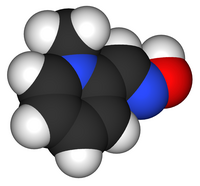This article needs additional citations for verification. (March 2023) |
 | |
 | |
| Clinical data | |
|---|---|
| Other names | 1-methylpyridine-6-carbaldehyde oxime |
| AHFS/Drugs.com | Micromedex Detailed Consumer Information |
| Pregnancy category |
|
| ATC code | |
| Legal status | |
| Legal status |
|
| Identifiers | |
| |
| CAS Number | |
| PubChem CID | |
| IUPHAR/BPS | |
| DrugBank | |
| ChemSpider | |
| UNII | |
| KEGG | |
| ChEBI | |
| ChEMBL | |
| CompTox Dashboard (EPA) | |
| ECHA InfoCard | 100.027.080 |
| Chemical and physical data | |
| Formula | C7H9N2O+ |
| Molar mass | 137.162 g·mol−1 |
| 3D model (JSmol) | |
| |
| |
| (verify) | |
Pralidoxime (2-pyridine aldoxime methyl chloride) or 2-PAM, usually as the chloride or iodide salts, belongs to a family of compounds called oximes that bind to organophosphate-inactivated acetylcholinesterase.[1] It is used to treat organophosphate poisoning[2] in conjunction with atropine and either diazepam or midazolam. It is a white solid.
- ^ Jokanović M, Stojiljković MP (December 2006). "Current understanding of the application of pyridinium oximes as cholinesterase reactivators in treatment of organophosphate poisoning". European Journal of Pharmacology. 553 (1–3): 10–7. doi:10.1016/j.ejphar.2006.09.054. PMID 17109842.
- ^ Jokanović M, Prostran M (2009). "Pyridinium oximes as cholinesterase reactivators. Structure-activity relationship and efficacy in the treatment of poisoning with organophosphorus compounds". Current Medicinal Chemistry. 16 (17): 2177–88. doi:10.2174/092986709788612729. PMID 19519385.